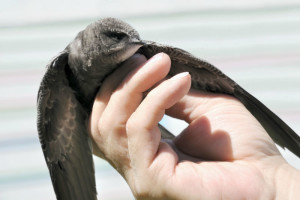With spring just around the corner, many animals will begin looking for places to build their nests and lay their eggs. Unfortunately, some birds may view your chimney as the perfect nesting place for their young ones.
One animal that is well known for trying to nest in chimneys is the chimney swift – it’s even in their name! While it may not seem like a major problem, a chimney swift nest in your chimney can be a serious nuisance as they are a protected species that cannot be moved. The following information about chimney swifts can help homeowners recognize these birds, understand how they get into chimneys, and find ways to keep them out.

What are chimney swifts?
Chimney swifts are very small grey and brown birds with cigar shaped bodies and wide, short bills. Chimney swifts are easily identified by their distinctive chirp as well as their sharp, jerky movements when flying. While chimney swifts spend their non-breeding winters in South America, they migrate back to North America for the spring nesting season each year. According to the Cornell Lab of Ornithology , “Their ability to travel over long distances and through a variety of habitats exposes them to a wide range of microorganisms.”
Why chimney swifts love to nest in chimneys
In year’s past, chimney swifts preferred to nest in hollow or dead trees. However, as cities have grown larger and wooded areas are harder to find, chimney swifts have been forced to adapt. In fact, chimney swifts got their name because they often seek out chimneys as their nesting sites.
Chimney swifts most commonly find their way into uncapped chimneys or chimneys with damaged chimney caps. Because they are so small, even the smallest hole in the netting or mesh of a chimney cap can be big enough for a tiny swift to fit through. Because they are a migratory bird that will return year after year to the same nesting site, it is important to have your chimney repaired as soon as the swifts have left to avoid their return.
I have swifts in my chimney – now what?
When you first discover an animal has nested in your chimney, the natural reaction is to want them removed as soon as possible. Unfortunately, chimney swifts are a protected species whose nests cannot be moved.
Chimney swifts, along with a variety of other migratory birds, are protected by the Federal Migratory Bird Treaty Act. This law bans the removal or destruction of any migratory bird nests that have eggs or hatchlings. Thankfully for homeowners, chimney swifts have a short nesting cycle; in the span of about six weeks, the birds will nest, lay and hatch eggs, and have their hatchlings leave the nest.
While chimney swifts are a nuisance, they are a protected species that cannot be removed once they have built their nests. Because of this, they best way to keep them out is by preventative measures like spark arrestors or netting. For more information on chimney swifts and how to keep them out of your chimney this year, contact Lords Chimney today!
